Search results for: 'Art'
-
 Ptolemaic sarcophagus mask
Ptolemaic sarcophagus maskImpressive wood relief of an idealized face. Remains of paint. The mask was part of a sarcophagus lid from Ancient Egypt during ptolemaic rule.
Price: on request Greek fibula from Italy
Greek fibula from ItalyLovely silver brooch from the Greek colonies in Southern Italy. Late classical to early hellenistic period.
€690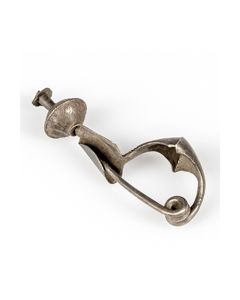 Greek fibula from the colonies in Southern Italy
Greek fibula from the colonies in Southern ItalyLovely silver brooch and piece of jewellery. Late classical to early hellenistic period.
€750 Greek fibula from the colonies in Southern Italy
Greek fibula from the colonies in Southern ItalySilver brooch in near perfect condition. Late classical to early hellenistic period.
Price: on request Tanagra figure of a bride from Henry H. Gorringe collection
Tanagra figure of a bride from Henry H. Gorringe collectionHenry Honychurch Gorringe (1841-1885) was responsible for the removal of Cleopatra's Needle from Alexandria, Egypt to Central Park in New York City.
Price: on request Egyptian bronze figurine of Osiris
Egyptian bronze figurine of OsirisWell preserved figure of this important god of the ancient Egyptian pantheon. From an old museum collection.
Price: on request Coptic bronze figurine of a running boy
Coptic bronze figurine of a running boyFrom the famous Prof. Maurice Bouvier collection, acquired in Egypt between 1929 and 1959.
Price: on request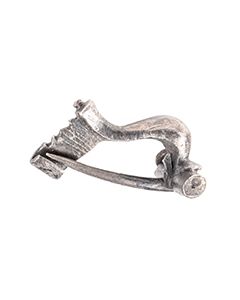 Roman silver knee brooch
Roman silver knee broochNice specimen with characteristic bend in its bow and attached loop and ring. From the Danubian provinces of the Roman Empire.
Price: on request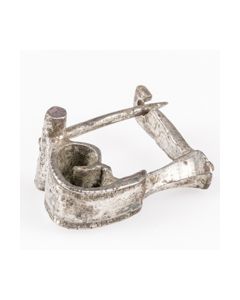 Roman silver fibula from Pannonia
Roman silver fibula from PannoniaInteresting brooch type from the Roman Pannonian provinces. A very similar piece was found near the Roman camp and settlement of Carnuntum in what is now Austria.
Price: on request Pannonian trumpet brooch
Pannonian trumpet broochWell preserved Roman silver fibula with curved bow. The type is from the Pannonian provinces of Rome and dates to the 2nd century.
Price: on request Egyptian mummy beads necklace
Egyptian mummy beads necklaceModern assembled and threaded necklace made from original ancient Egyptian beads. The socalled mummy beads are made of faience and date to the Late Period of ancient Egypt.
Price: on request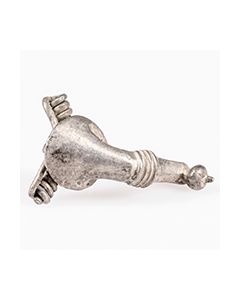 Pannonian trumpet brooch
Pannonian trumpet broochWell preserved Roman fibula made of silver. The type is from the Pannonian provinces of Rome and dates to the 2nd century.
Price: on request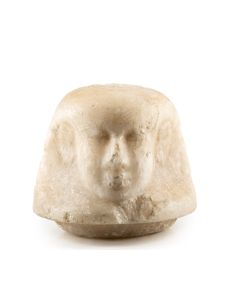 Large canopic jar lid with Imsety
Large canopic jar lid with ImsetyEgyptian Late Period canopic jar lid in the shape of a human head. The piece is impressive due to its massive size and high-quality craftsmanship.
Price: on request Daunian jug with high handle
Daunian jug with high handleItalic pottery in the subgeometric style. Made around 500 BC in Apulia. Handled vessels of this type are an guiding form in Apulian archaeology.
Price: on request Gallo-Roman animal fibula
Gallo-Roman animal fibulaZoomorphe Fibel mit Wildtier als Motiv. Schmuckstück mit religiöser Symbolik, vergleichbar einem Kreuzanhänger bei heutigen Christen. Gefertigt im 1. bis 3. Jh. n. Chr. in Gallien.
Price: on request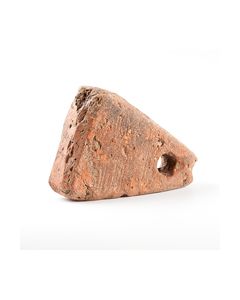 Roman clay loom weight
Roman clay loom weightMassives Gewicht aus Terrakotta mit Öse zur Aufhängung als Webgewicht, aus der römischen Kaiserzeit, Germanische Provinzen, 1. bis 2. Jh. n. Chr.
Price: on request Late Bronze age socketed axe head
Late Bronze age socketed axe headKörper mit ovalem Querschnitt und charakteristischer Öffnung am Nacken, für die einfache Schäftung des Beilkopfes. Derartige Beile wurden in der späten Bronzezeit als Arbeitsgeräte vielfältig eingesetzt. Spannendes Belegstück.
Price: on request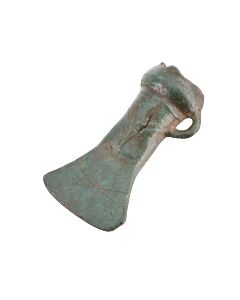 Socketed axe head with beautiful patina
Socketed axe head with beautiful patinaKörper mit ovalem Querschnitt und charakteristischer Öffnung am Nacken, für die einfache Schäftung des Beilkopfes. Dieses Exemplar besticht besonders durch seine schöne Patina, einem Zeugnis der vergangenen Jahrhunderte.
Price: on request Small socketed axe head from the late Bronze Age
Small socketed axe head from the late Bronze AgeBronzezeitlicher Beilkopf mit vierkantigem Querschnitt. Schön erkennbarer Grat von der Herstellung in einer Gussform. Ringöse an der Seite. Späte Bronzezeit.
Price: on request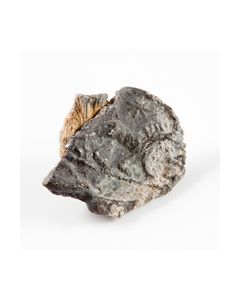 Siegelabdruck mit Resten von Flachs
Siegelabdruck mit Resten von FlachsAbdruck eines Siegels in Blei mit schreitendem Löwen, darüber ein Stern. Hellenistische Zeit, 2. Jh. v. Chr., aus Miletos. Außerordentlich selten ist der erhaltene Rest von antikem Flachs!
Price: on request Bronzezeitliches Tüllenbeil
Bronzezeitliches TüllenbeilBeilkopf aus der späten Bronzezeit Mitteleuropas in museumswürdiger Erhaltung. Farbenfrohe Patina. V-förmige Verzierungen auf zwei Seiten. 1000 v. Chr. bis 800 v. Chr.
Price: on request Bronzezeitliche Teekanne
Bronzezeitliche TeekanneSeltener, kugelförmiger Gefäßtyp mit kurzem Hals und Ausguss. Wichtiger Vorläufertyp für die Keramiken der kommenden Jahrhunderte. 2250 v. Chr. bis 1800 v. Chr. Fund aus Palästina.
Price: on request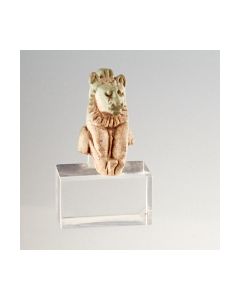 Egyptian amulet of a lion headed goddess
Egyptian amulet of a lion headed goddessAttributed to Sekhmet, goddess of war and protection from illness. Very nice and detailed fayence work. Dating to the Third Intermediate Period to Late Period of Ancient Egypt.
Price: on request Scarab with magic spell
Scarab with magic spellThe hieroglyphs are of the so called anra design, a magic spell in the ancient Egyptian belief. The scarab is from the 13th to 15th dynasty. It is described in the catalogue of Gautier-Vodoz.
Price: on request Phoenician eye bead
Phoenician eye beadPolychrome glass bead with stylized elements of a face as protection against the evil eye. Produced in Carthage or the Phoenician homeland, 4th to 3rd century BC.
Price: on request Phoenician eye bead
Phoenician eye beadPolychrome glass bead with stylized elements of a face as protection against the evil eye. Produced in Carthage or the Phoenician homeland, 4th to 3rd century BC.
Price: on request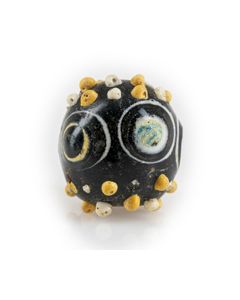 Large Phoenician eye bead
Large Phoenician eye beadDark and unusually large glass bead with stylized elements of a face as protection against the evil eye. Produced in Carthage or the Phoenician homeland, 4th to 3rd century BC.
Price: on request Phoenician eye bead
Phoenician eye beadPolychrome glass bead with stylized elements of a face as protection against the evil eye. Produced in Carthage or the Phoenician homeland, 4th to 3rd century BC.
Price: on request Phoenician eye bead
Phoenician eye beadPolychrome glass bead with stylized elements of a face as protection against the evil eye. Produced in Carthage or the Phoenician homeland, 4th to 3rd century BC.
Price: on request Phoenician eye bead
Phoenician eye beadPolychrome glass bead with stylized elements of a face as protection against the evil eye. Produced in Carthage or the Phoenician homeland, 4th to 3rd century BC.
Price: on request Phoenician eye bead
Phoenician eye beadPolychrome glass bead with stylized elements of a face as protection against the evil eye. Produced in Carthage or the Phoenician homeland, 4th to 3rd century BC.
Price: on request Phoenician eye bead
Phoenician eye beadPolychrome glass bead with stylized elements of a face as protection against the evil eye. Produced in Carthage or the Phoenician homeland, 4th to 3rd century BC.
Price: on request Bronze Age flanged axe
Bronze Age flanged axeWorking axe from the Late Bronze Age of Europe in great condition. Typologically, it is a flanged axe head.
Price: on request Phoenician eye bead
Phoenician eye beadPolychrome glass bead with stylized elements of a face as protection against the evil eye. Produced in Carthage or the Phoenician homeland, 4th to 3rd century BC.
Price: on request Phoenician eye bead
Phoenician eye beadPolychrome glass bead with stylized elements of a face as protection against the evil eye. Produced in Carthage or the Phoenician homeland, 4th to 3rd century BC.
Price: on request Phoenician eye bead
Phoenician eye beadPolychrome glass bead with stylized elements of a face as protection against the evil eye. Produced in Carthage or the Phoenician homeland, 4th to 3rd century BC.
Price: on request

